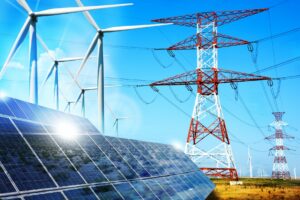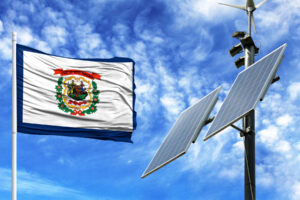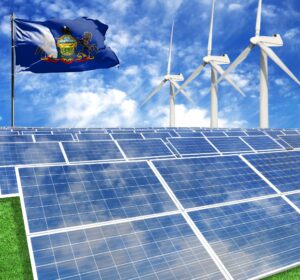 On September 8, 2021, the Department of Energy (DOE) released its Solar Futures Study providing a blueprint for the role of solar energy in decarbonizing the nation’s power sector. The 310-page Study outlines a future in which solar provides 40% of the nation’s electricity supply by 2035 through cost reductions, technological improvement, rapid deployment, and supportive policies. And, with the electrification of buildings and the transportation sector, solar could also power 30% of all building end uses and 14% of transportation end uses by 2050.
On September 8, 2021, the Department of Energy (DOE) released its Solar Futures Study providing a blueprint for the role of solar energy in decarbonizing the nation’s power sector. The 310-page Study outlines a future in which solar provides 40% of the nation’s electricity supply by 2035 through cost reductions, technological improvement, rapid deployment, and supportive policies. And, with the electrification of buildings and the transportation sector, solar could also power 30% of all building end uses and 14% of transportation end uses by 2050.
The Study identifies several policy initiatives needed to support the deployment of solar at this scale, including decarbonization targets, R&D investments and cost reductions, changes to wholesale electricity market regulation, and transmission development, to name a few. In order to meet the 40% by 2035 goal, the Study estimates that the U.S. must install an average of 30 GW of solar capacity per year between now and 2025 and 60 GW per year from 2025-2030, with a total of 1,000 GW of solar deployed by 2035. If the solar industry sees this level of growth, the Study estimates that the industry could employ up to 1.5 million people by 2035. The Study also highlights the important role that battery storage and demand-side management will play given that solar power varies based on daily and seasonal patterns.
With solar power currently providing approximately 3% of the nation’s electricity supply, the DOE’s 40% goal will be contingent on many factors supporting the industry in the coming years, including cost reductions, supportive policies, and widespread deployment.
 A financial rebound is in progress as COVID-19 becomes less of a driver to business and our general livelihood, and it is one that is apparent in the renewables sector. Experts see growth fueled not just by pent-up demand, but also growing attention to ESG considerations and renewables’ financial advantages.
A financial rebound is in progress as COVID-19 becomes less of a driver to business and our general livelihood, and it is one that is apparent in the renewables sector. Experts see growth fueled not just by pent-up demand, but also growing attention to ESG considerations and renewables’ financial advantages.
Corporate merger and acquisition activity was up significantly with solar developers expanding their pipelines, oil and gas companies diversifying into renewables, and funds buying up renewable assets.
According to Mercom CEO Raj Prabhu, Solar project acquisitions reached a record high in the second quarter, he said, with more than 24.7 GW of capacity acquired. That total came from 34 corporate M&A deals, compared to 20 in the first quarter of this year and 13 in the second quarter of 2020.
In the first half of 2021, solar project acquisitions reached 39.3 GW, more than doubling the 14.7 GW acquired in the first half of 2020.
Venture capital funding in particular has experienced a strong recovery. Funding for VC was 680% higher in the first half of the year, compared with last year, with $1.6 billion raised in 26 deals, according to Mercom.
Renewables have been rapidly gaining market share for years. In 2020, the United States saw its fifth consecutive year of renewables consumption growth, reaching a record high of 12% of the country’s total consumption, according to the U.S. Energy Information Administration (EIA).
EIA estimates solar energy accounted for about 11% of last year’s renewable energy consumption, and “overall, 2020 U.S. solar consumption increased 22% from 2019.”
By comparison, the agency said fossil fuel consumption fell last year by 9% to “the lowest level in nearly 30 years.”
The trend is represented globally as well. The International Energy Agency’s (IEA) most recent market update, released in May, found renewable electricity capacity added in 2020 rose by 45% to 280 GW.
“Solar PV installations will continue to break new records, with annual additions forecast to reach over 160 GW by 2022,” IEA said in its analysis. “That would be almost 50% higher than the level achieved in 2019 prior to the pandemic, affirming solar’s position as the ‘new king’ of global electricity markets.”
Corporate solar interest surges as companies exit pandemic and turn focus to ESG issues | Utility Dive
 The West Virginia Legislature has passed a bill that will make it easier for retail electric customers to establish on-site solar energy facilities. Sponsored by Babst Calland Shareholder and House Judiciary Chairman Moore Capito, House Bill 3310 states that solar energy facilities designed to power only the premises where they are located are exempt from the jurisdiction of the West Virginia Public Service Commission under certain conditions. This means that the PSC is not involved in regulating the rates and other aspects of qualifying solar facilities. To be exempt, power generated from such a facility must be subject to a “power purchase agreement” with the retail electric customer. A PPA generally governs the design, permitting, financing, and installation of a solar facility at a retail electric customer’s location by a solar energy developer. Under a PPA, a retail customer purchases the power generated by the facility at an agreed upon rate. In addition to receiving revenue generated from the energy produced, the developer is also eligible for renewable energy tax credits. The bill is intended to promote solar installations at residences, small businesses, and industrial sites by allowing third-party developers to design and finance the installation of solar panels and then sell the electricity generated to the consumer.
The West Virginia Legislature has passed a bill that will make it easier for retail electric customers to establish on-site solar energy facilities. Sponsored by Babst Calland Shareholder and House Judiciary Chairman Moore Capito, House Bill 3310 states that solar energy facilities designed to power only the premises where they are located are exempt from the jurisdiction of the West Virginia Public Service Commission under certain conditions. This means that the PSC is not involved in regulating the rates and other aspects of qualifying solar facilities. To be exempt, power generated from such a facility must be subject to a “power purchase agreement” with the retail electric customer. A PPA generally governs the design, permitting, financing, and installation of a solar facility at a retail electric customer’s location by a solar energy developer. Under a PPA, a retail customer purchases the power generated by the facility at an agreed upon rate. In addition to receiving revenue generated from the energy produced, the developer is also eligible for renewable energy tax credits. The bill is intended to promote solar installations at residences, small businesses, and industrial sites by allowing third-party developers to design and finance the installation of solar panels and then sell the electricity generated to the consumer.
To be exempt from PSC jurisdiction, an on-site solar facility must be “located on and designed to meet only the electrical needs of the premises of a retail electric customer” and be designed not to exceed certain generation limits: 25 kilowatts for residential customers; 500 kilowatts for commercial customers; and 2,000 kilowatts for industrial customers. The legislation also establishes a cap on the aggregate amount of exempt on-site solar energy generation within West Virginia. The total of all solar PPAs and net metering arrangements cannot exceed 3% of an electric utility’s aggregate customer peak demand in the state during the previous year. Under a net metering arrangement, a retail customer who generates more power through an on-site solar facility than the customer uses will receive a credit for the excess power that is sent out to the grid rather than consumed.
Before entering into a PPA for an on-site solar facility, a retail customer must notify the electric utility. If the electric utility does not notify the customer within 30 days that a cap has already been reached, the customer may proceed with the project.
If you have any questions about House Bill 3310 or solar development in West Virginia, please contact Robert M. Stonestreet (681.265.2117; rstonestreet@babstcalland.com) or Moore Capito (681.205.8953; mcapito@babstcalland.com)
 On March 21, 2021, Pennsylvania Governor Tom Wolf announced the Pennsylvania “Project to Utilize Light and Solar Energy” (“PULSE”), a renewable energy project consisting of seven new solar farms totaling 191 MW in capacity to be constructed in various counties across the Commonwealth by 2023. Upon completion, the PULSE Project is expected to provide upwards of 360,000 MWh of electricity each year, estimated to be enough to supply nearly half of the state government’s annual electricity consumption. Billed as the largest solar commitment by any government in the US, 16 Commonwealth agencies are expected to use electricity generated from the PULSE Project, including, among others, the Pennsylvania Departments of Environmental Protection, Conservation and Natural Resources, Transportation, and Health, as well as the Game and Fish & Boat Commissions.
On March 21, 2021, Pennsylvania Governor Tom Wolf announced the Pennsylvania “Project to Utilize Light and Solar Energy” (“PULSE”), a renewable energy project consisting of seven new solar farms totaling 191 MW in capacity to be constructed in various counties across the Commonwealth by 2023. Upon completion, the PULSE Project is expected to provide upwards of 360,000 MWh of electricity each year, estimated to be enough to supply nearly half of the state government’s annual electricity consumption. Billed as the largest solar commitment by any government in the US, 16 Commonwealth agencies are expected to use electricity generated from the PULSE Project, including, among others, the Pennsylvania Departments of Environmental Protection, Conservation and Natural Resources, Transportation, and Health, as well as the Game and Fish & Boat Commissions.
Part of Governor Wolf’s “GreenGov” initiative, the PULSE Project is a public-private partnership between the Commonwealth, Lightsource BP, and Constellation. Under the project, Lightsource BP will finance, construct, own and operate the solar farms, which will be built in Columbia, Juniata, Montour, Northumberland, Snyder, and York Counties. Pursuant to a Power Purchase Agreement, Constellation, an electricity supplier, will purchase electricity generated from the solar farms and distribute it to the Commonwealth’s participating agencies under a 15-year fixed-price supply agreement. Expected benefits of the PULSE Project include an estimated reduction of 157,000 metric tons of carbon dioxide emissions each year and creation of over 400 jobs.
 On September 8, 2021, the Department of Energy (DOE) released its Solar Futures Study providing a blueprint for the role of solar energy in decarbonizing the nation’s power sector. The 310-page Study outlines a future in which solar provides 40% of the nation’s electricity supply by 2035 through cost reductions, technological improvement, rapid deployment, and supportive policies. And, with the electrification of buildings and the transportation sector, solar could also power 30% of all building end uses and 14% of transportation end uses by 2050.
On September 8, 2021, the Department of Energy (DOE) released its Solar Futures Study providing a blueprint for the role of solar energy in decarbonizing the nation’s power sector. The 310-page Study outlines a future in which solar provides 40% of the nation’s electricity supply by 2035 through cost reductions, technological improvement, rapid deployment, and supportive policies. And, with the electrification of buildings and the transportation sector, solar could also power 30% of all building end uses and 14% of transportation end uses by 2050. A financial rebound is in progress as COVID-19 becomes less of a driver to business and our general livelihood, and it is one that is apparent in the renewables sector. Experts see growth fueled not just by pent-up demand, but also growing attention to ESG considerations and renewables’ financial advantages.
A financial rebound is in progress as COVID-19 becomes less of a driver to business and our general livelihood, and it is one that is apparent in the renewables sector. Experts see growth fueled not just by pent-up demand, but also growing attention to ESG considerations and renewables’ financial advantages. The West Virginia Legislature has passed a bill that will make it easier for retail electric customers to establish on-site solar energy facilities. Sponsored by Babst Calland Shareholder and House Judiciary Chairman Moore Capito,
The West Virginia Legislature has passed a bill that will make it easier for retail electric customers to establish on-site solar energy facilities. Sponsored by Babst Calland Shareholder and House Judiciary Chairman Moore Capito,  On March 21, 2021, Pennsylvania Governor Tom Wolf
On March 21, 2021, Pennsylvania Governor Tom Wolf